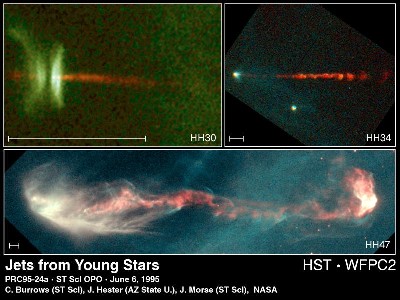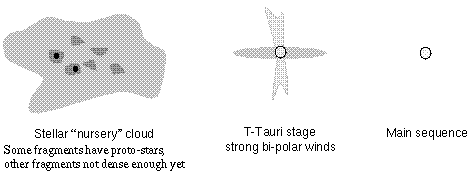
The young star will produce strong winds in the T-Tauri stage, named after the prototype star in the constellation Taurus. These strong winds eject much of the surrounding cocoon gas and dust. The winds are constrained to flow preferentially along the rotation axes by the disk of dust and gas. With most of the cocoon gas blown away, the forming star itself becomes visible to the outside for the first time. The HST images below show jets shooting out from three young stars. The disk around one star is seen in the top left frame. Select the image to get an enlarged view in another window. The scale in the bottom left corner of each frame represents 150 billion kilometers, or 1,000 times the distance between Earth and the Sun (over twelve times Pluto's entire orbit; courtesy of Space Telescope Science Institute). See the video of the observed evolution over 14 years of observations of HH 34 and HH47.

Stars initially begin their lives near other stars in a cluster. After a few orbits around the galactic center, gravitational tugs from other stars in the galaxy cause the stars in the cluster to wander away from their cluster and live their lives alone or with perhaps one or two companions. The Pleiades are a young cluster of stars easily visible in the shoulder of the Taurus (the Bull) constellation during the winter months. They are about 80 million years old (compare that to our Sun which is 4,600 million = 4.6 billion years old!). The gas and dust around the stars may be residual material from their formation or simply interstellar clouds the cluster is passing through.

A star remains at a given spectral type during the entire main sequence stage---the main sequence is not an evolutionary sequence. For example, a F-type star formed as a F-type star and will remain a F-type star during the entire main sequence stage. Only if the star has a very close companion may a change occur if gas is transferred between the stars in the system. The main sequence star does slowly increase in luminosity with only a slight change in its surface temperature as the helium builds up in its core. Our Sun's luminosity is now about 30% greater than when it formed.

![]() Go back to previous section --
Go back to previous section --
![]() Go to next section
Go to next section
last updated: June 24, 2022